
The City of Wells in Somerset, England is named for its wells that bubble up from an underground river fed by the rain water that seeps through the rocks of the nearby Mendip Hills. In Saxon times the presence of this water led people to believe that Wells was a sacred place and during this period the first church was built here. The main wells, the wells of Saint Andrew, are inside the grounds of the Bishop’s Palace and this was where I started my visit. I arrived just in time to join the tour of the grounds (included in the price of the entrance fee). is the only cathedral town in the UK where the bishop still lives in the Bishop’s Palace. But he only occupies a part of the building, three other families live there including the head gardener who is in charge of the sluice gates that control the water that runs through the grounds and into the town via the fountain in Market Place.

Our tour started in the first courtyard of the palace, just inside the main entrance, known as the Bishop’s Eye Gateway. This gate was built by Bishop Bekynton (1443 – 1465) as an entrance to the Bishop’s Palace from the Market Place – an amenity that Bekynton gave to the people of Wells in 1451. The first courtyard is known as the Bishop’s Eye because from here the Bishop could keep an eye on the townsfolk. This entrance is the only one that still has its original gates. The Gatehouse was designed to house the mechanism for raising and lowering a drawbridge and portcullis. There were guardrooms on either side of the entrance. Above the entrance there are holes in the vault through which boiling oil could be poured on unwelcome visitors. The drawbridge was last raised in 1831 when news came that the Bishop of Bristol’s Palace had been burnt to the ground during riots about electoral reform. Today the gatehouse is the home of the Operations Manager of the Bishop’s Palace.

On the far side of the courtyard is the palace building and next to that the ruins of the Great Hall. This vast hall was built by the very wealthy Bishop Burnell (1275 to 1292) to entertain Edward 1. Although this king never visited the Bishop’s Palace Edward III did visit the palace in 1331. During the second half of the sixteenth century the lead in the roof of the Great Hall was stripped off and the building began to decay. During the nineteenth century Bishop Law partly demolished the building and created the Picturesque Garden inside the ruins.

After walking through the gardens, admiring the toilet in a tower on our way, we climbed onto the walls that surround the palace. Beyond these walls is the moat filled with water from the wells. The moat and the walls were built to protect the occupants of the palace from possible insurrections. There was no sign of the famous swans that live on this moat. During the 1870s the daughters of Bishop Hervey taught the resident swans to ring a bell for food. A trick that has been passed down from swan to cygnet for several generations. When there is someone in the kitchen the rope on the bell is let down so the swans know that ringing the bell will bring a reward.
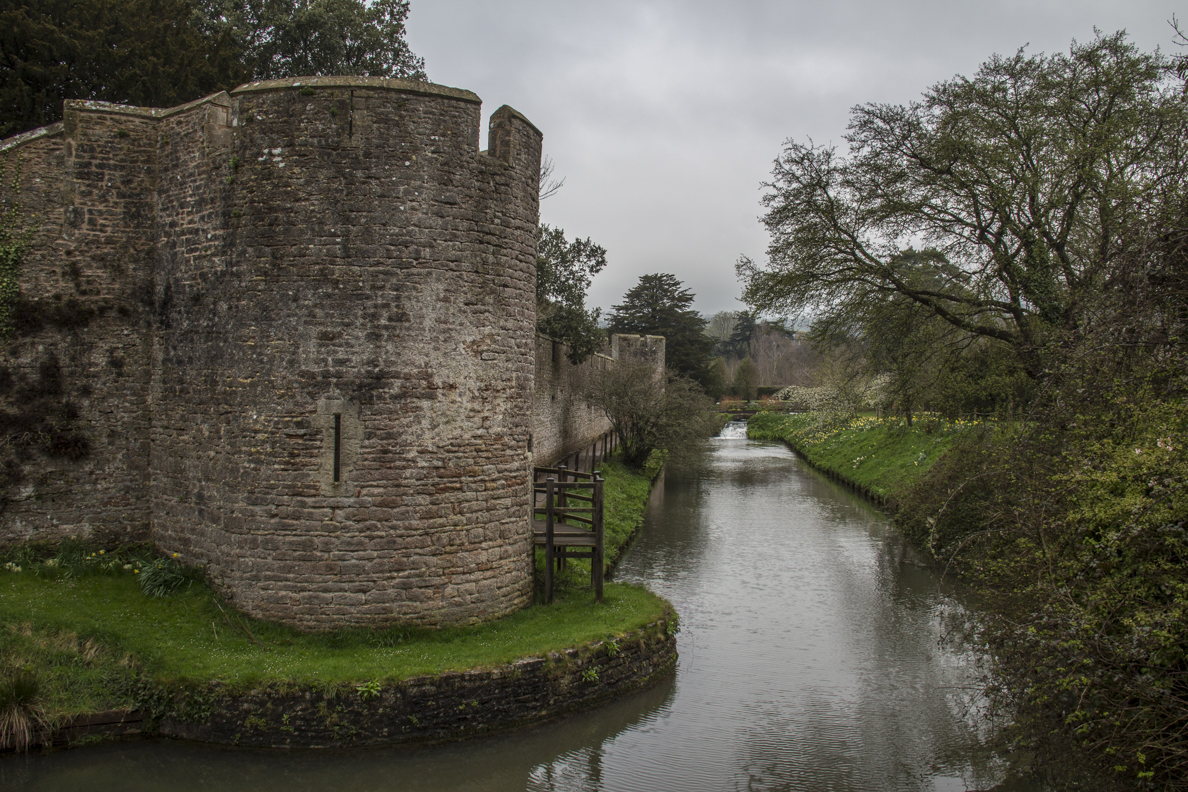
In the grounds of the palace there are two sets of wings donated by the sculptor Edgar Phillips. They were part of an exhibition in 2014 called A Light Shining in Darkness featuring stained glass and metal. On the far side of the formal gardens at the back of the palace we went through the walls and crossed a bridge into some more gardens. This part of the garden is a complex of small pools and channels fed by the underground river. Sometimes it is possible to see the water bubbling up from the Bottomless Well the first pool we came to. Bishop Law (1824 – 1845) enclosed a group of three small wells springs to create a new pond. On a still day this pool perfectly mirrors the cathedral. After heavy rain the flow of water increases and the Palace gardeners can open the sluice gates to let more water into the moat so that this pool does not overflow.

For centuries the wells have provided clean water for people living nearby. Saint Andrew’s Well is the furthest pool and the oldest. In 705 King Ine of Wessex gave land near these wells to Aldhelm his bishop so that he could build a minster. The Saxon Minster lay just south of the present Cathedral. A stream from this well flowed close beside the minster. Water might have been taken from this stream for use in some church ceremonies. The wells’ unceasing flow through the city would have been very significant in the Middle Ages. Wells, with its ceaseless waters could have been seen as the earthly reflection of the perfect city described in the Book of Revelation in the Bible. The waterwheel in the Palace grounds (encased in a small pump house) was installed in the 1800s to power a pump which supplied water to the Palace for domestic use. However, in the 1870’s Bishop Hervey’s children caught typhoid fever. He suspected contaminated water had caused their illness. He may well have been right – most of the city’s wells were eventually classed as unfit for drinking as liquid sewage from cess pits leached into underground water sources.

At the end of the tour we were left to explore some other areas of the extensive grounds which are now managed jointly with the Royal Horticultural Society. Bishop Peter Price Garden of Reflection. is a modern garden in an ancient setting. This garden reflects one bishop’s ideas about how to help people live well in the modern world. He wanted to offer them a quiet, calm, protected place for reflection in the Palace grounds and close to the cathedral. I thought it was rather a strange modern landscape but it does have lovely views of the cathedral beyond the Palace. There is a back entrance from the palace into the cathedral but this is closed to visitors. The Community Garden continues an old, treasured tradition of growing food and other produce for the Palace. This garden is a space for people from the local community to become part of that tradition and to learn new skills and share their experience. Fruit, vegetables and herbs grown here help supply the kitchen of the Bishop’s Table (the palace café). Medieval bishops and their households ate produce grown in the same soil and watered by the same streams. There is also the bishop’s Camery, the medieval name for the enclosed gardens outside the moat. This area was probably an orchard irrigated by a stream running towards the moat. Today an arboretum has taken the place of the orchard. It was planted in 1977 to commemorate Queen Elizabeth II silver jubilee. The old stream is covered with a culvert but it still waters the roots of the trees. The Dragons Lair is beyond the arboretum. This is a play area for children paying homage to a legend that in the twelfth century Somerset was terrorised by a frightful dragon that liked to eat milkmaids and other unsuspecting villagers. Bishop Jocelin, who built the Bishop’s Palace in 1206, bravely ventured out to kill the dragon. After a might battle as the dragon breathed its dying breath it cast an eternal curse on the villagers: that if they ever forgot about it, the creature would return every fifty years. This dragon is not only remembered in the gardens but also through a festival held in the town.

Later that day I joined a tour that went inside the palace itself (also included in the price of the ticket). It started in the Bishop’s Chapel. This chapel, dedicated to the Holy Trinity and Saint Mark, is the private chapel of the Bishop of Bath and Wells. It was built by Bishop Burnell (1275 – 1292). The main stones of the building are the red and yellow Triassic sandstone and the finer local Doulting stone is used for the vaulting. The windows are large for the late thirteenth century and the tracery is an example of the English Decorated style. Finding the chapel in a derelict state Bishop Law (1824 – 1845) restored it. In the east window, which had been boarded up, he used some fragments of French medieval glass which had come from Rouen following the destruction of churches during the French Revolution. The pews were carved by local woodworkers in the early twentieth century. The names of the parishes where they lived can be seen in the carved patterns. In order to celebrate eight hundred years of the Bishop’s Palace the altar and chair designed by David John were dedicated in 2006. The materials used are maple wood and Ancaster stone. Around its walls are the coats of arms of all the bishops with a mitre at the top except for the Roman Catholic bishops whose coats of arms were topped by an image of the Catholic head wear.

A door at the back of the chapel gives access to the entrance hall of the palace. This hall was restored during Victorian times. The wooden panelling on the walls is not actually wood because they ran out of money during the restoration so the panels and door lintels are made from papier mache. There is a playing card on the ceiling and no-one seems to know how that got there. But there is a nice story attached to it concerning a magician performing at a wedding reception (the Palace is available to hire for functions). It seems he asked a guest to take a card and write his name on it. Later, this card later mysteriously appeared on the ceiling. The entrance hall and the parallel Undercroft created a firm foundation for the first floor hall above them built by Bishop Jocelin. Using red and yellow Triassic sandstone, the mason chose the finer Doulting stone for the vaulting. Before the sixteenth century fireplace was installed the space would have been heated with charcoal burners. The windows contain fragments of the Rouen stained glass collected by Bishop Law. Spiral stone stairs at both ends of the hall provided access to the first floor hall and long gallery. One is by the doorway into the chapel. In the seventeenth century the other was replaced by the wooden staircase that is still in use today. Of particular interest in the entrance hall is the long refectory table (refurbished top but original footings) where Bishop Ken (1684-1690) shared meals with twelve poor men and women when he was in residence. Over the Tudor fireplace is a coat of arms combining the arms of Bath and Wells.
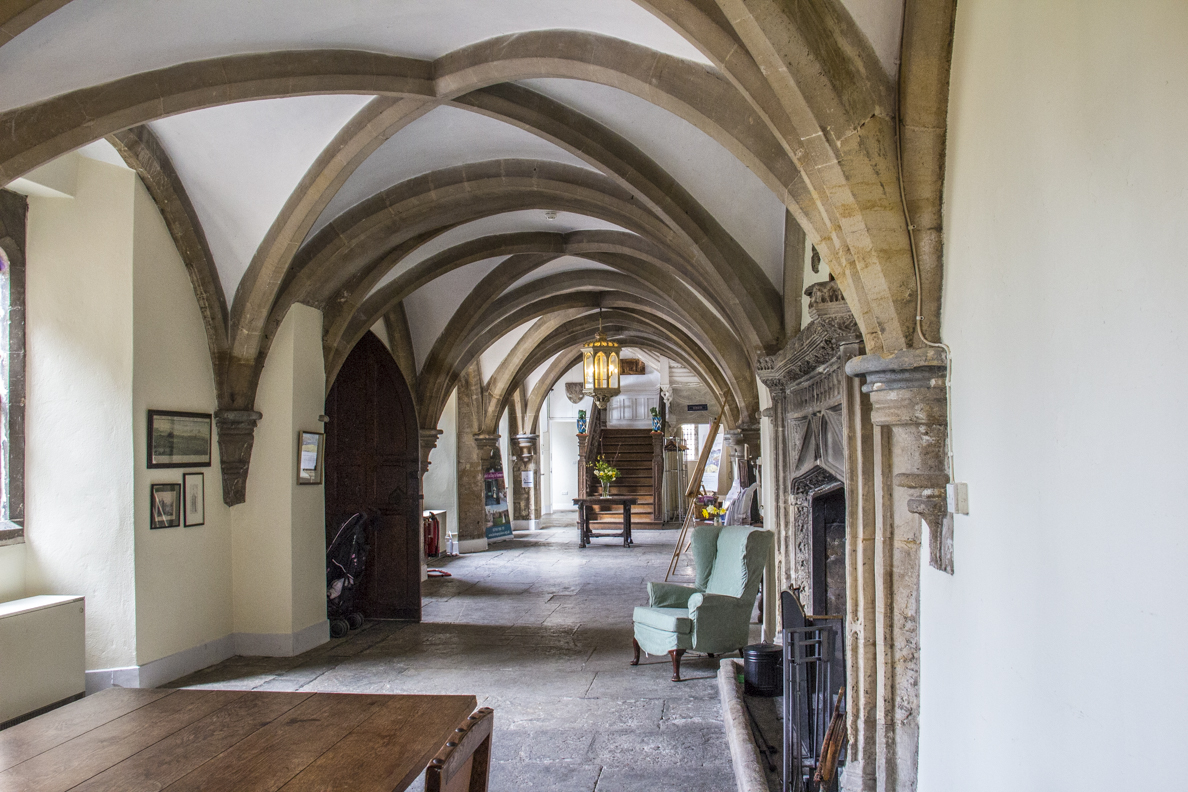
Adjoining the entrance hall is the Undercroft. The workmanship dates back to the thirteenth century. Vaulted with Doulting stone the pillars that support the state rooms above are blue lias stone. The new floor is Purbeck capstone. The windows are very similar to their original appearance. In past centuries the Undercroft was partitioned and used as a wine store, a buttery, pantries, a cellar for coal and fire wood and accommodation for servants. Bishop Law displayed his collections of minerals and fossils here. Bishop Hervey (1869 – 1894), who had a large family, converted the Undercroft into a dining room. As the kitchen was some distance away food was kept warm by a ‘hot steam and hot water apparatus’ in a room which is today’s modern kitchen.
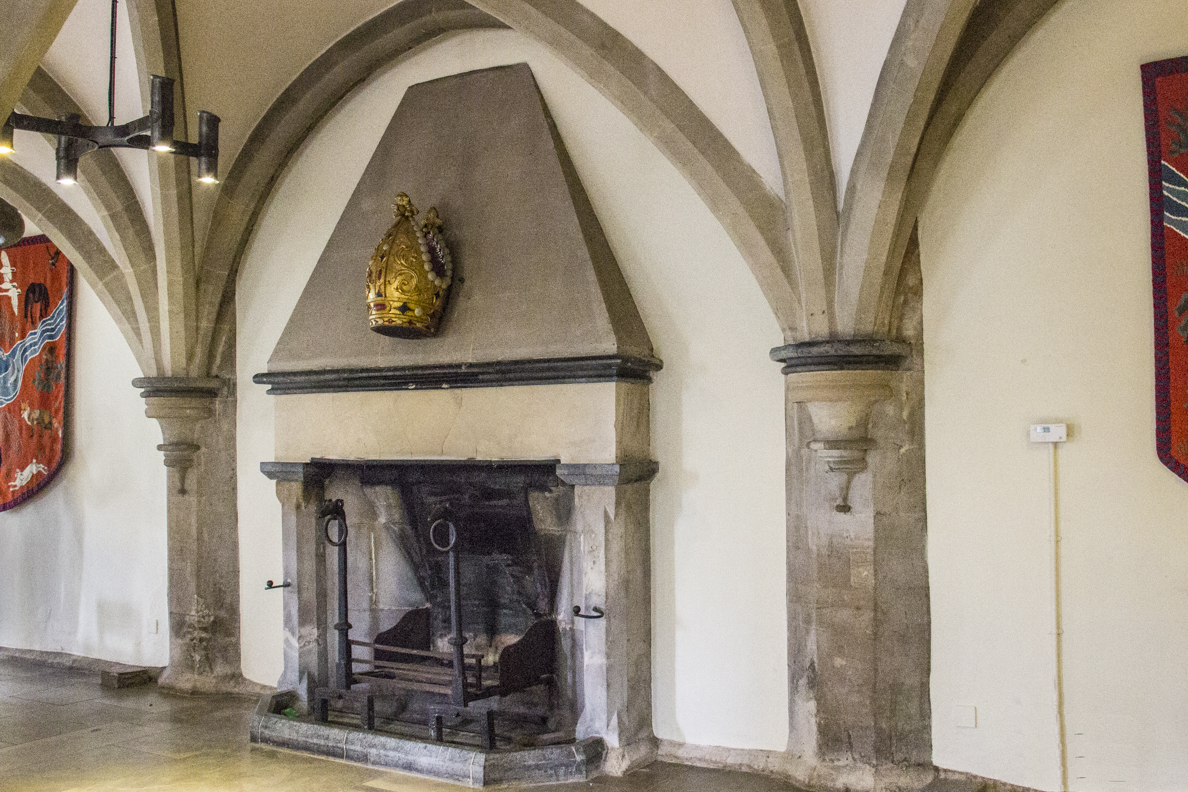
The wooden Jacobean staircase in the entrance hall, installed by Bishop Montague (1608 – 1616) goes up to the first floor hall and long gallery. This staircase was originally painted in the style of the period but the paintwork was stripped off in the 1970s. Today the only colour is in the four carvings of green Somerset dragons on the bannisters. These bear the arms of Bath (key and sword) and Wells (cross of the patron saint, Saint Andrew). The wall paper is a modern copy of the one used in the House of Lords by Augustus Welby Northmore Pugin and it helps to make the transition to the Victorian era of decoration on the first floor.
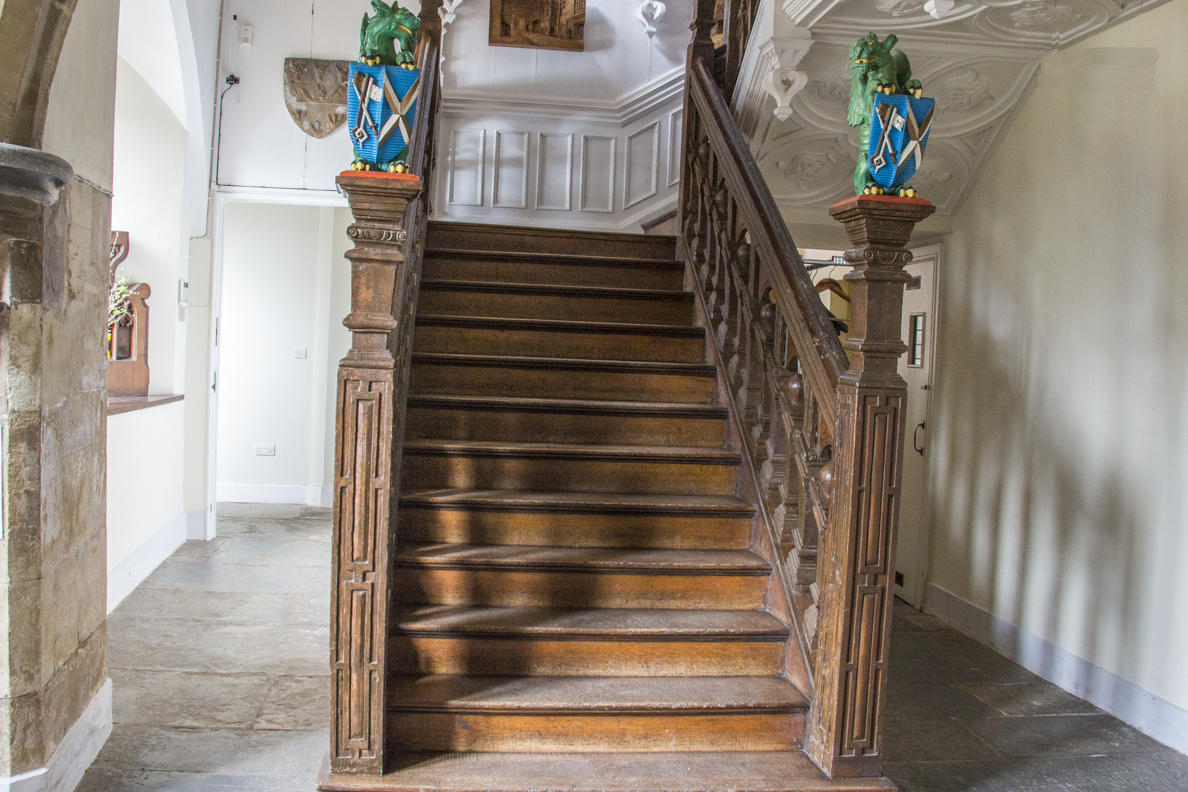
At the top of the stairs is the Long Gallery. In medieval times a long gallery was an essential space for work and recreation and this space may have been divided into three rooms. During the Civil War between king and parliament the royalist forces made their headquarters in the palace. The parliamentary forces camped on Penn Hill, damaged the Long Gallery with cannon fire. When the parliamentary troops entered Wells, the palace was looted and portraits and an organ were stolen. Following the Civil War, the palace was neglected for several decades. By 1824 Bishop Law had turned it into a comfortable Georgian residence and began the present collection of portraits. When Bishop Bagot (1845 – 1854) built another floor over the Long Gallery this enabled the architect Benjamin Ferrey to renovated the whole of the first floor. In the Long Gallery, windows were enlarged, plaster ceilings installed and the decoration carried out in Victorian Italian Gothic style.

We moved into the Dressing Room. In the thirteenth century this room and the adjoining Conference Room was Bishop Jocelin’s Great Hall. The hall was once open to the beams and rafters of the roof and painted stonework of the walls. It was untouched by the building work over the Long Gallery and the windows in this room overlooked the deer park. In 1977 two of the original window embrasures were found behind Victorian bookcases. These spaces now contain the Glastonbury Chair and Abbot’s Chair. In past centuries this room has been used as a nursery, a music room, a drawing room and finally as Bishop Bradfield (1946 – 1960) study. He later moved his office and family accommodation to the north wing of the Palace which had been built as servants’ quarters by Bishop Beckynton. In this room is the coronation cape worn by Bishop Bradfield at the coronation of Queen Elizabeth II. The next room, the Panelled Room is used for temporary exhibitions.
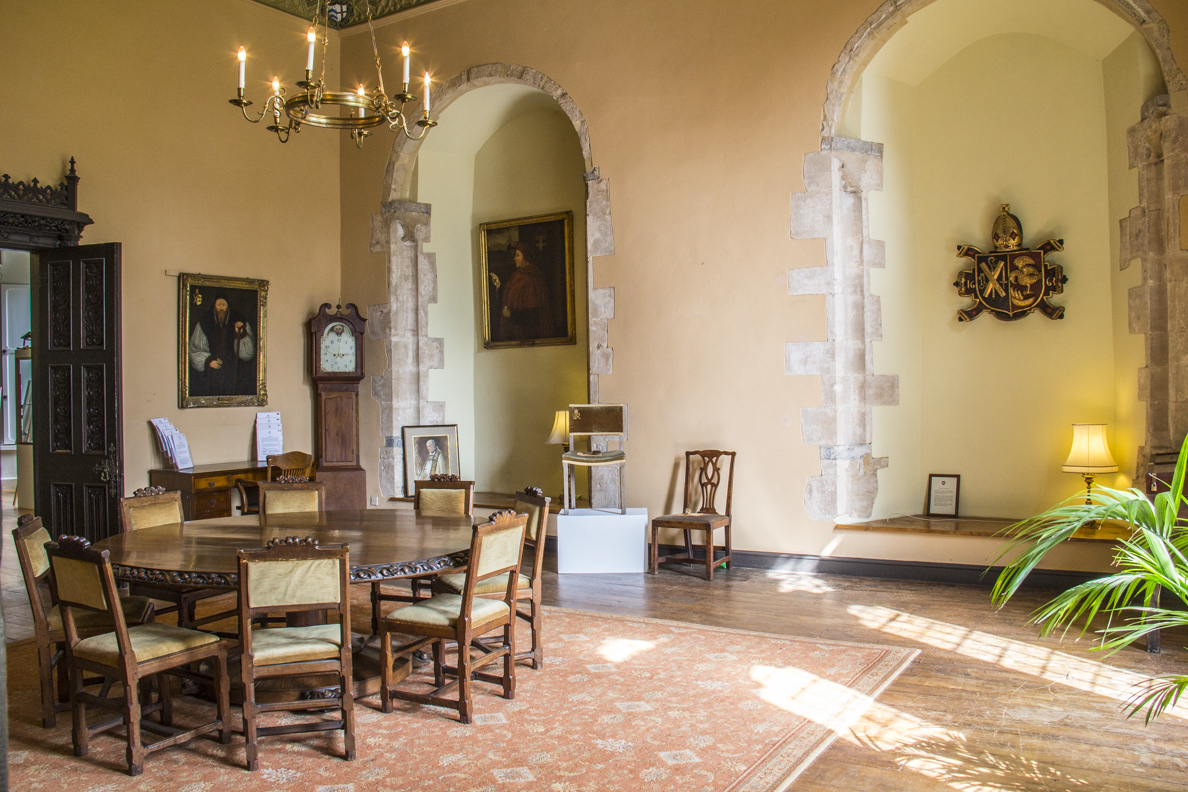
As we walked around the palace our guide treated us to anecdotes about the different bishops who once lived here. My favourite was about Bishop Bickersteth (1975 – 1987) who was famous for culling the ducks on the moat as he did not like hybrid ducks. My visit was really enhanced by the two very interesting tours I did, both led by John King. And after the Bishop’s Palace there was more to come – the Cathedral and the town were next on my agenda.
Where to Stay
While visiting Wells I stayed at The Cross in Croscombe where I was warmly welcomed by the owner, Terri Chichester. Conveniently placed for visiting Wells it was just far enough away to experience the tranquillity of a village and enjoy the Mendips landscape. I really enjoyed my stay at The Cross.

Now Available on GPSmyCity.com
This article is now featured on GPSmyCity. To download this article for offline reading or travel directions to the attractions highlighted in this article, go to Walking Tours in Wells on GPSmyCity